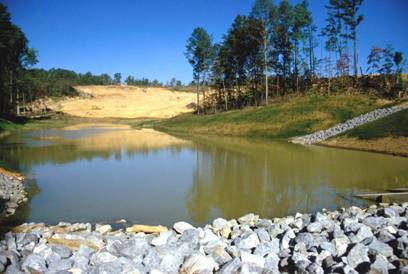Rock Dam

Definition
A rock embankment constructed across a drainageway or other suitable location to create a temporary basin for collecting sediment.
Purpose
To trap sediment on the construction site and prevent off-site sedimentation. Useful where earth fill material is not readily available.
Where Practice Applies
Where a temporary measure is needed to retain sediment from a construction area -but not in a natural stream.
Design Criteria
Drainage area:
Limited to 50 acres.
Design life:
Limited to 3 years.
Sediment storage:
1800 cubic feet per acre disturbed, as a minimum. Measured one foot below spillway crest.
Dam crest height
Limited to 8 feet.
Basin Area and Shape
The largest surface area gives the greatest trapping efficiency. Basin length-to-width ratio should be 2:1 minimum.
Spillway capacity
10-year peak runoff, at maximum flow depth of one foot and minimum freeboard of one foot. Entire length of dam between rock abutments may serve as spillway.
Rock embankment
- Top width: 5 ft minimum
- Side slopes: Upstream, 2:1 or flatter; Downstream, 3:1 or flatter
- Earth abutments: Smooth, stable slopes, 2:1 or flatter.
- Rock abutments: must protect earth abutments and extend along downstream face to toe of dam. Abutments must be at least 1 ft. higher than the spillway face at all points.
- Height: 2 ft minimum above spillway crest
- Width: 2 ft thick, minimum
- Side slopes: 2:1 or flatter
Outlet protection
Rock apron, 1.5 ft thick, minimum, zero grade, length equal to height of dam or extended to stable grade, whichever is greater.
Rock material
Well-graded, hard, angular, weather-resistant stone with a "d50 " of 9 inches minimum.
Protection from piping
Extra-strength filter fabric covering entire foundation including earth abutments and apron.
Basin dewatering
Through one-foot thick minimum layer of 1/2-to 3/4-inch aggregate on upstream face of dam.
Installation
- Divert runoff from undisturbed areas away from the basin. Delay clearing pond area until dam is in place.
- Excavate foundation for apron and use it as a temporary sediment basin during construction of dam.
- Clear and grub area under darn, removing all root mat and other objectionable material. Grade earth abutments no steeper than 1:1.
- Dispose of material in approved location. If cutoff trench is required, excavate at center line of dam, extending all the way up earth abutments.
Protection from Piping
- The entire foundation including both earth abutments must be covered by filter fabric. Overlap one foot at all joints, upstream strip over downstream strip.
- Smooth the foundation area before placing filter fabric. Be careful placing rock on fabric. It may be helpful to place a 4-inch layer of sand over fabric before placing rock.
Embankment and Pool
- Construct embankment to dimensions shown on plans. Use wellgraded, hard, angular, weather-resistant rock. Rock abutments must be at least 2 feet higher than the spillway crest and at least 1 foot higher than the downstream face of dam at all points.
- Divert sediment-laden flow to upper end of basin. Set marker stake to indicate clean out elevation where sediment pool is 50%full.
- Establish vegetation to stabilize all disturbed areas except the lower one-half of sediment pool as shown in the plan.
Safety
Sediment basins that impound water are hazardous. Basin should be dewatered between storms. Avoid steep side slopes. Fences with warning signs may be necessary if trespassing is likely. State and local requirements must be followed.
Common Trouble Points
Failure from piping along abutments
Filter material not properly installed, or earth abutments too steep.
Stone displaced from face of dam
Stone size too small and/or face too steep.
Erosion below dam
Apron not extended to stable grade.
Erosion of abutments during spillway flow
Rock abutment height inadequate.
Sediment carried through spillway
Drainage area too large. Divert runoff from undisturbed area away from basin.
Sediment loss through dam
Inadequate layer of aggregate on inside face or aggregate too coarse to restrict flow through dam.
Maintenance
- Inspect rock dam and pool after each rainfall event.
- Remove sediment when it accumulates to one-half design volume (marked by stakes).
- Check structure and abutments for erosion, piping, or rock displacement. Repair immediately.
- Replace aggregate on inside face of structure when sediment pool does not drain between storms.
- Add fine gravel to upstream face of dam if sediment pool drains too rapidly (less than 6 hours) following a storm.
- Remove rock dam after the contributing drainage area has been permanently stabilized, inspected, and approved. Remove all water and sediment prior to removing dam. Dispose of waste materials in designated disposal areas. Smooth site to blend with surrounding area and stabilize according to vegetation plan.
References
North Carolina Department of Environment, Health, and Natural Resources, Erosion and Sediment Control Field Manual ,Raleigh, NC, February 1991.
Massachusetts Department of Environmental Protection, Office of Watershed Management, Nonpoint Source Program, Massachusetts Nonpoint Source Management Manual, Boston , Massachusetts, June,1993.